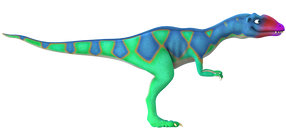
Zupaysaurus (/ˌzuːpeɪˈsɔːrəs/; "ZOO-pay-SAWR-us") is a genus of early theropod dinosaur living during the Rhaetian stage of the Late Triassic to Hettangian stage of the Early Jurassic of what is now Argentina. Although a full skeleton has not yet been discovered, Zupaysaurus can be considered a bipedal predator, up to 4 meters (13 ft) long. It may have had two parallel crests running the length of its snout.
Description[]
Zupaysaurus was a medium-sized theropod. An adult skull, measured approximately 450 mm (18 in) in length, suggesting a body length of approximately 4 m (13 ft) from its snout to the tip of its tail. Other estimates suggest that Zupaysaurus was at best 5.2 m (17 ft) long and weighed 200 kg (441 lb) at most. Like all theropods, Zupaysaurus walked only on its hindlegs, leaving its forelimbs free to grasp its prey. The length of the neck bones recovered suggests that this genus has a rather long neck. Like the coelophysoids, Zupaysaurus has a kink in its snout, between the premaxillary and maxillary bones of the upper jaw. It is estimated that Zupaysaurus had 24 teeth and an intermandibular hinge is present in the lower jaw. Only one specimen of Zupaysaurus is known to science. The holotype specimen was designated PULR-076, which consists of a nearly complete skull which was very well preserved, the right shoulder girdle, the lower right leg and ankle, and twelve vertebrae from the neck, back, and hips. Additional material of a smaller individual found at the same site may or may not belong to Zupaysaurus.
As Zupaysaurus was originally described, the head bore two thin parallel crests on top of the skull, similar to theropods like Dilophosaurus and Coelophysis kayentakatae. These crests are thought to have been formed by the nasal bones solely, unlike those of many other theropods which also incorporated the lacrimal bones. Crests on the skull were pervasive among theropods and may have been used for communicative purposes such as species or gender recognition. However, more recent analysis of the skull has cast doubt on the presence of these crests in Zupaysaurus. An unpublished abstract presented at a recent conference indicated the structures initially identified as crests were in fact the lacrimal bones displaced upwards during the process of fossilization. Other cranial ornamentation included a rugose laterally-projecting lacrimal ridge on the top of the skull.
A diagnosis is a statement of the anatomical features of an organism (or group) that collectively distinguish it from all other organisms. Some, but not all, of the features in a diagnosis are also autapomorphies. An autapomorphy is a distinctive anatomical feature that is unique to a given organism or group. According to Ezcurra (2006) and Ezcurra and Novas (2006), Zupaysaurus can be distinguished based on the following characteristics: the maxillary fenestra is within the antorbital fossa (according to Ezcurra, 2006), the rostral process of the lacrimal is ventrally bowed (according to Ezcurra, 2006), the ventral process of the squamosal is kinked (according to Ezcurra, 2006), wide contact between squamosal and quadratojugal (according to Ezcurra, 2006). The maxillary-jugal ventral margin describes an obtuse angle in lateral view (according to Ezcurra and Novas, 2006), a notch on the dorsal margin of the ascending process of the maxilla, relating to horizontal ramus of the lacrimal is rostrally tapering onto the forked caudal tip of the ascending process of the maxilla; (according to Ezcurra and Novas, 2006), a lacrimal with a highly pneumatized antorbital recess (according to Ezcurra and Novas, 2006), a short and square-shaped retroarticular process of the mandible (according to Ezcurra and Novas, 2006), the cnemial crest is poorly developed (according to Ezcurra and Novas, 2006).
Discovery[]
Discovered in May 1997 by Santiago Reuil ("Vultur"), part of the crew of Guillermo Rougier. It was later described by Arcucci and Coria and published in 2003. The name Zupaysaurus is composed of the Quechua word supay meaning "devil" and the Greek word sauros (σαυρος) meaning "lizard"; thus "devil lizard". In Incan mythology, supay was both the god of death and ruler of the ukhu pacha, the Incan underworld. The type species was named Z. rougieri in the honor of Guillermo Rougier, the scientist who led the expedition which discovered and collected the holotype (original specimen) PULR-076. Zupaysaurus was first described and named in the scientific journal Ameghiniana by Argentine paleontologists Andrea Arcucci and Rodolfo Coria in 2003.
